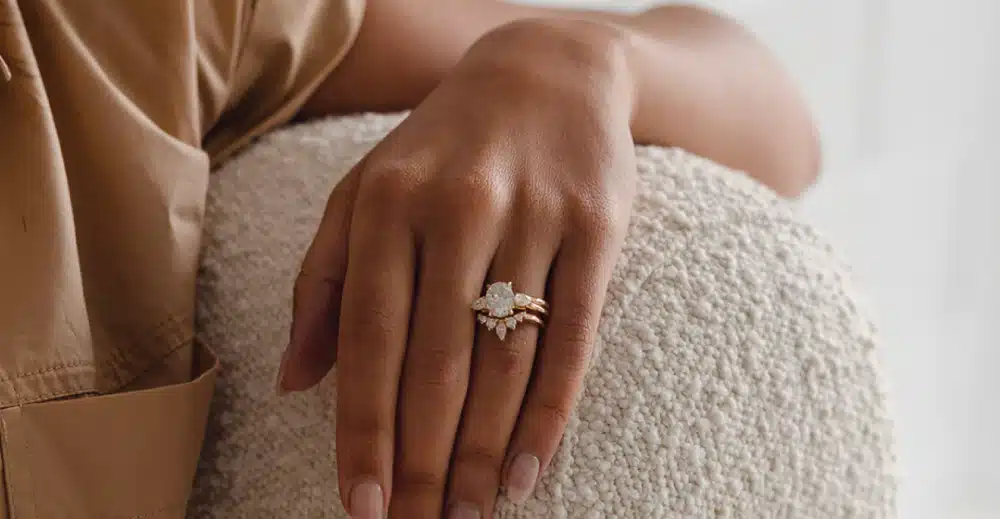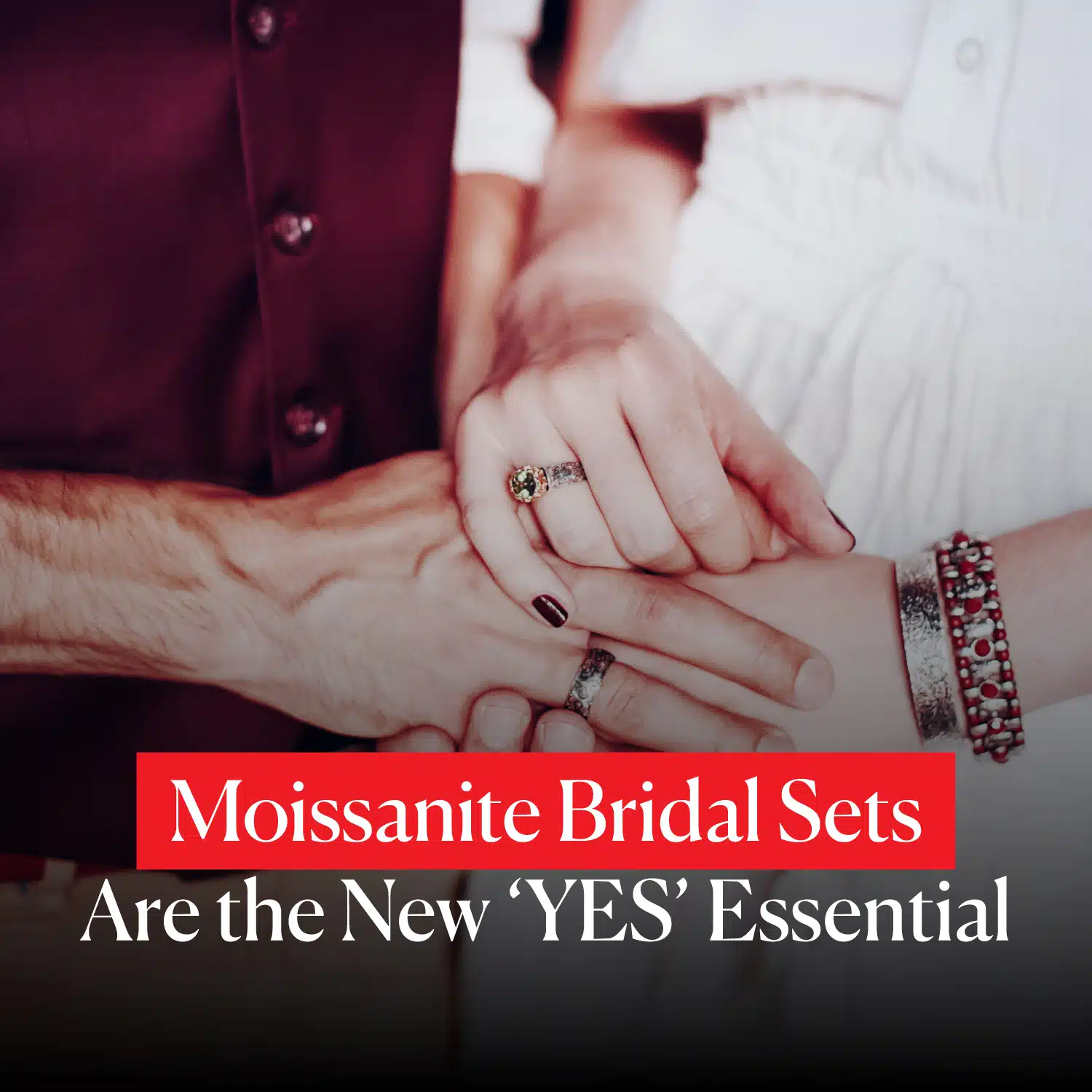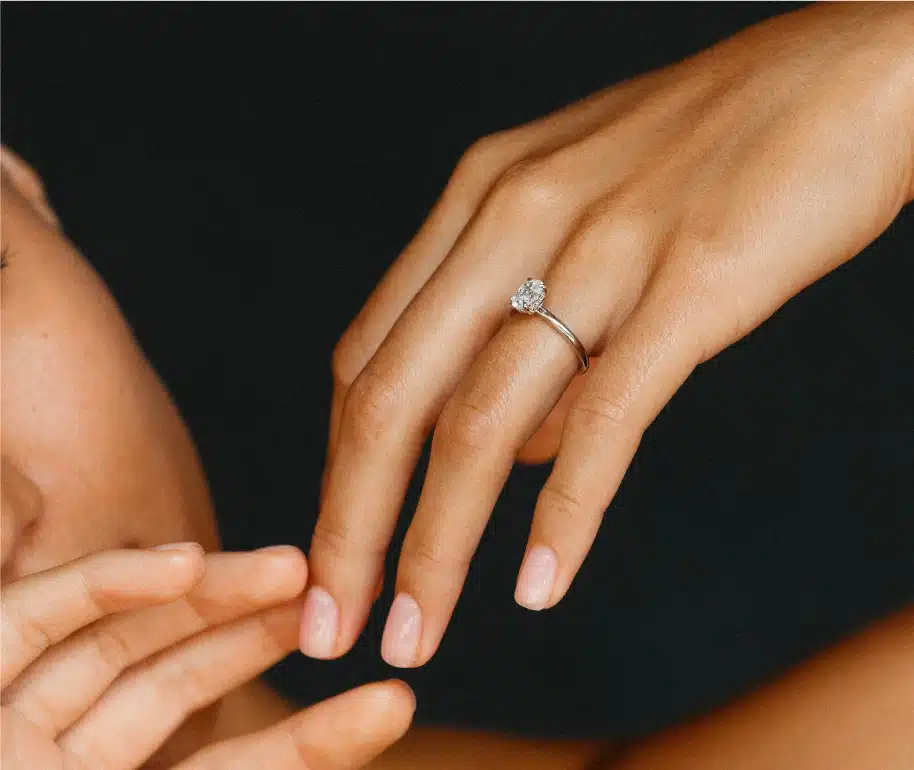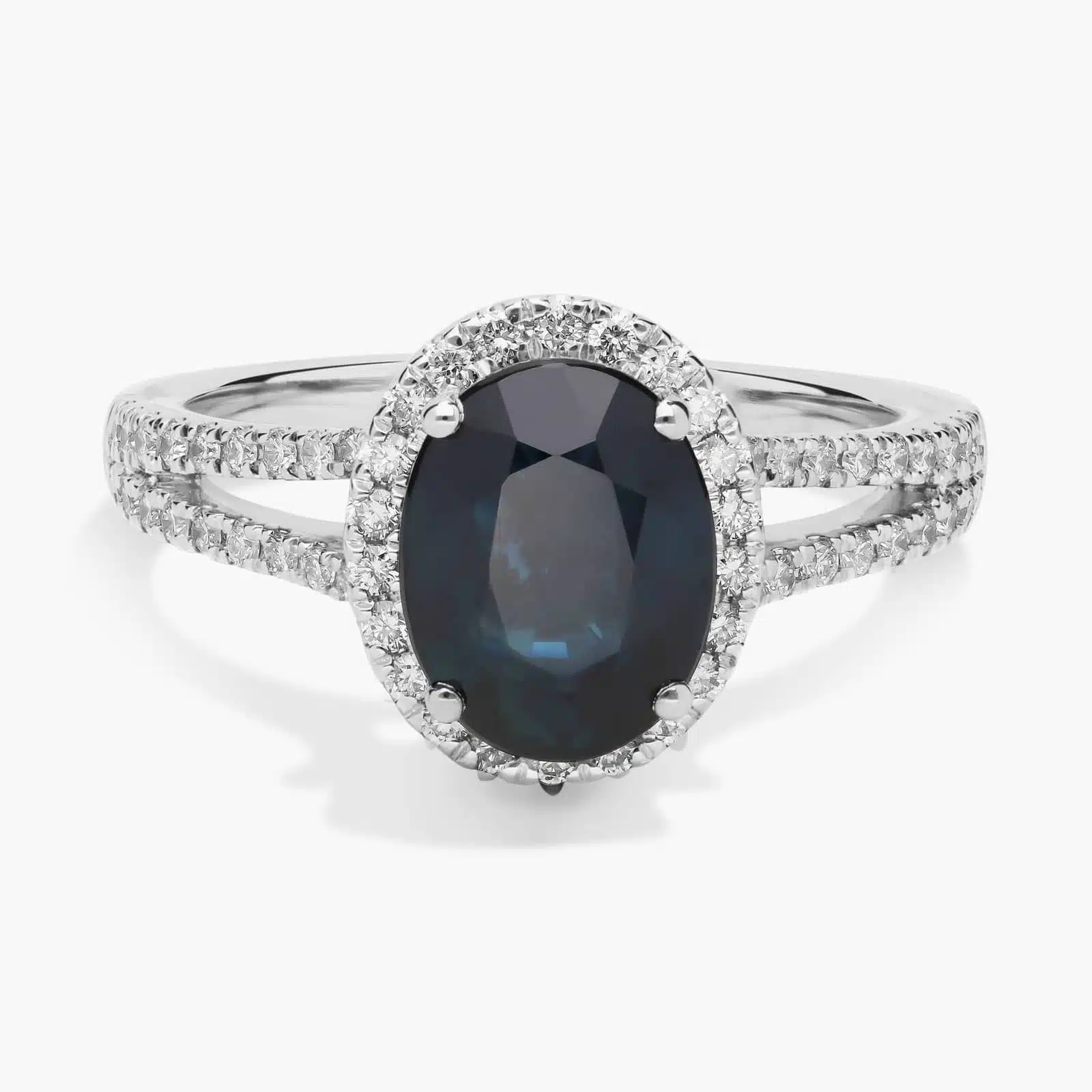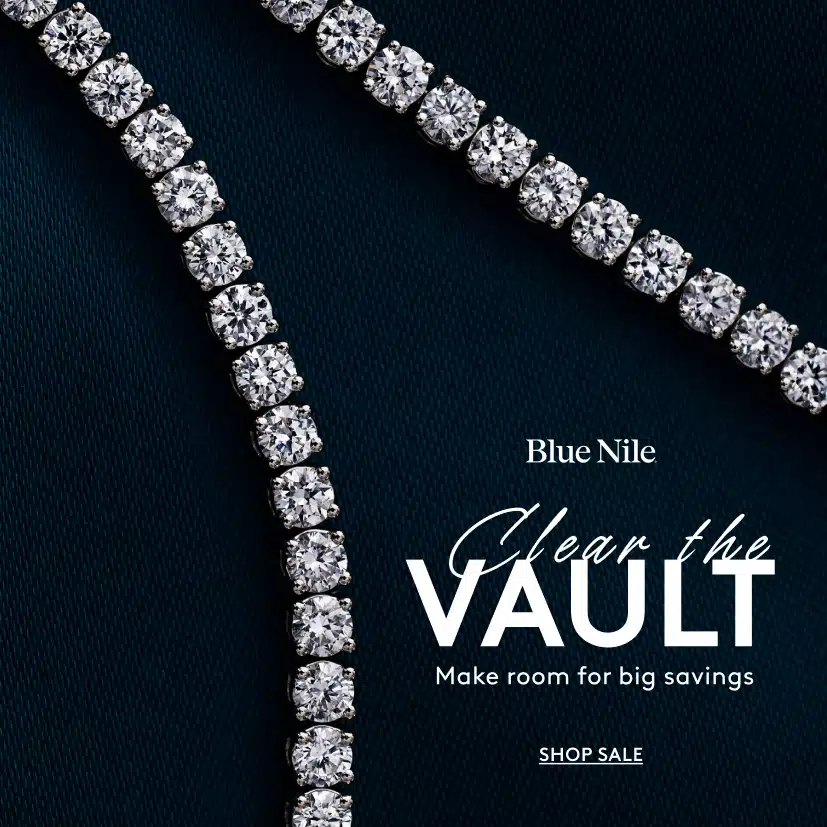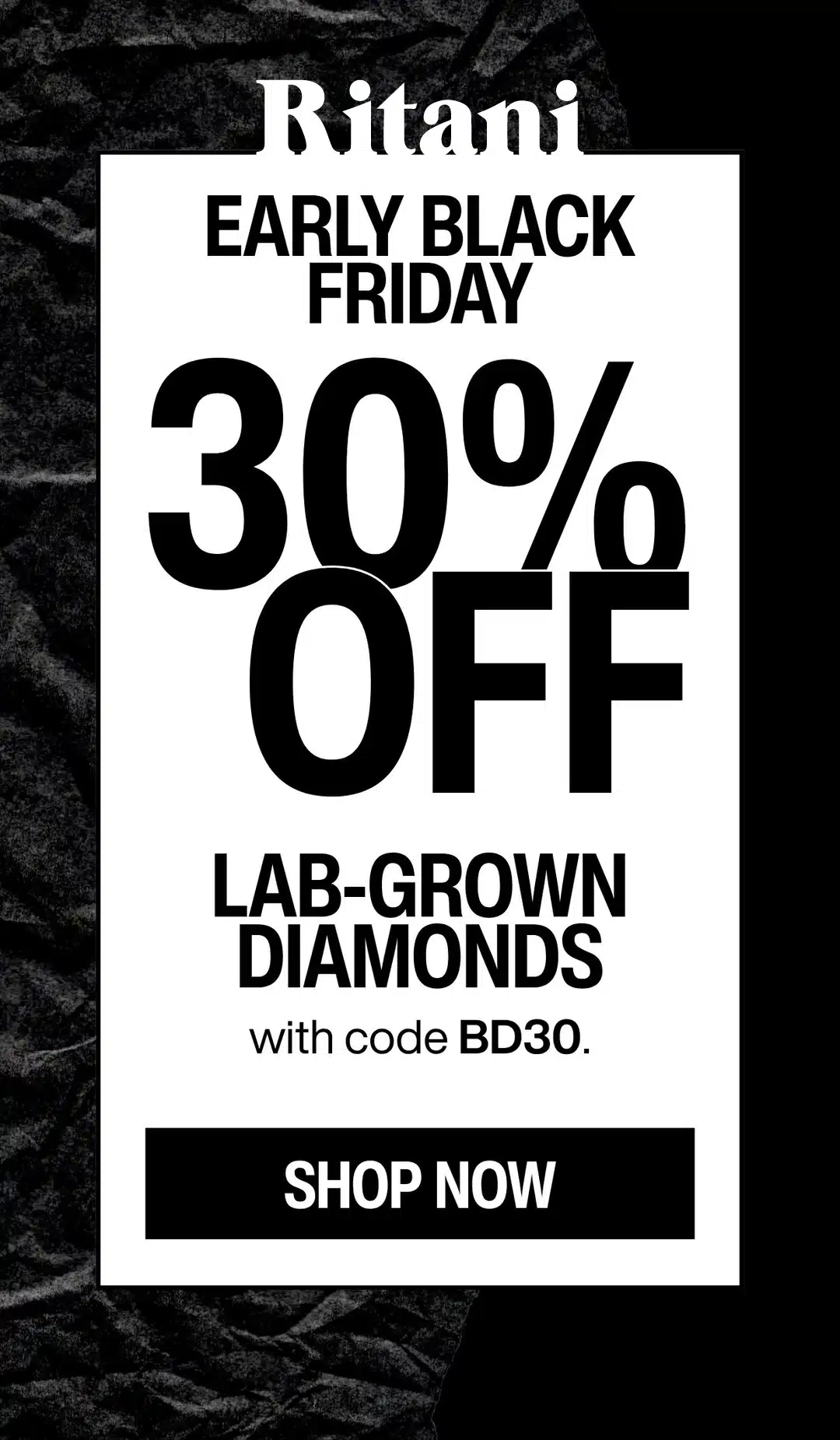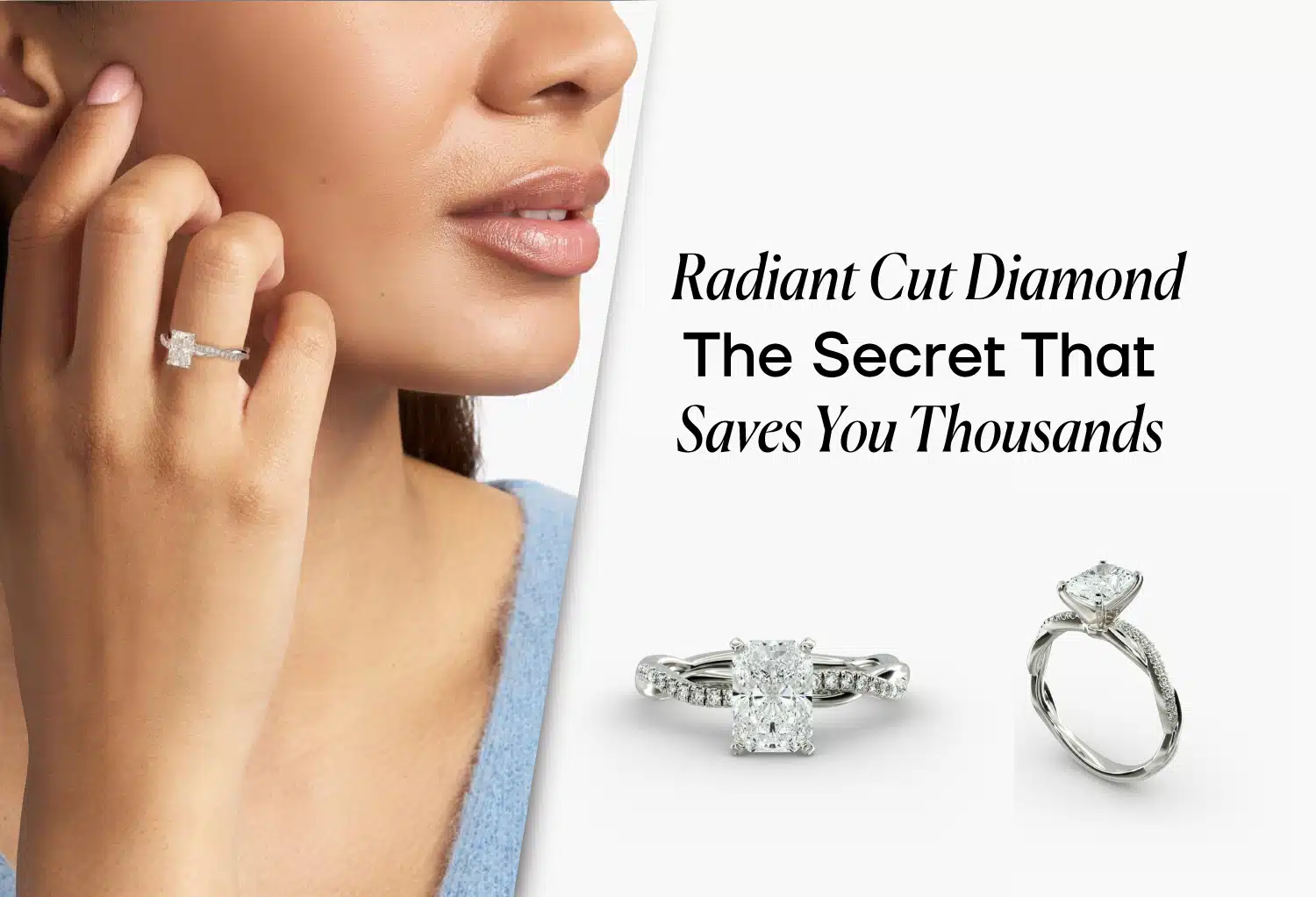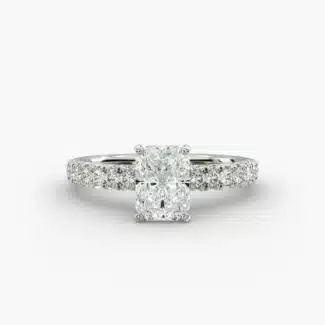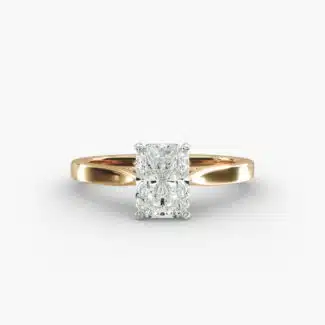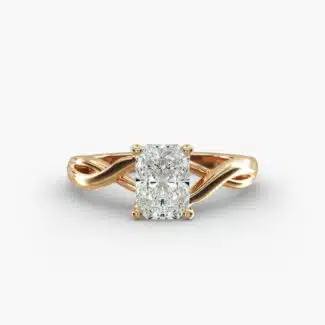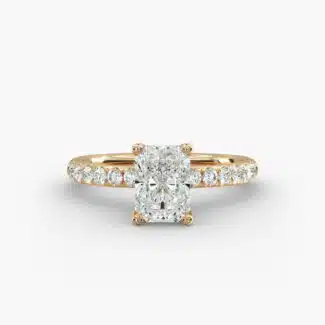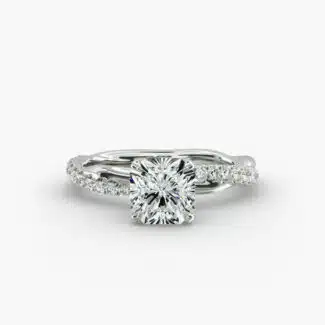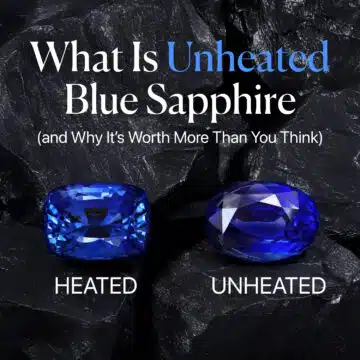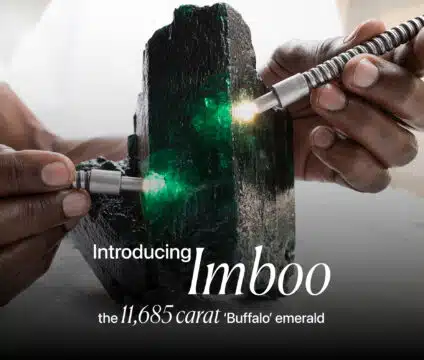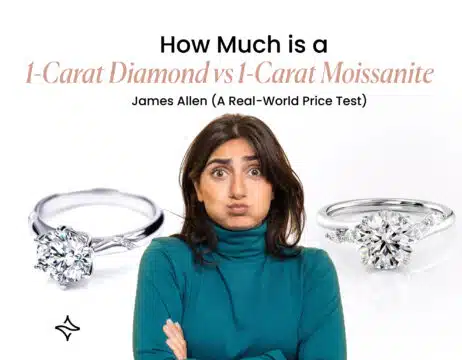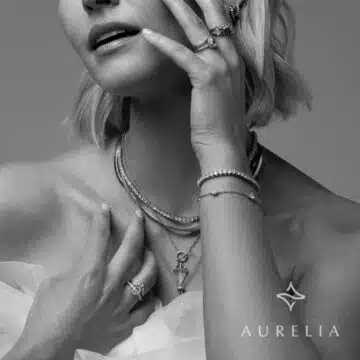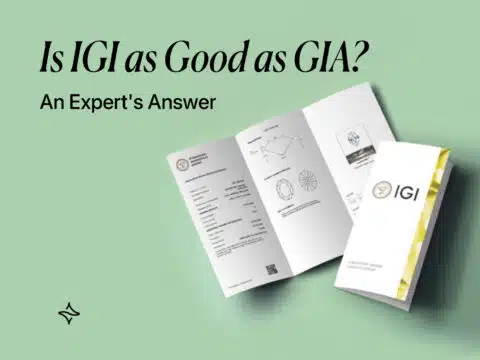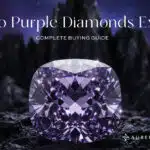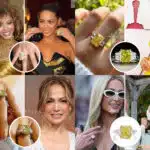The #1 secret to buying a radiant cut diamond and saving thousands is leveraging its “crushed-ice” brilliant facet pattern to safely choose a lower, more affordable clarity and color grade (like SI1 and H) that still looks flawless, which is the primary solution to avoiding the biggest mistake: overpaying.
You’re in love with the radiant cut—that stunning hybrid that seems to be the best of all worlds. It has the clean, rectangular shape of an elegant emerald cut but is packed with the fiery sparkle of a round brilliant. But it’s also incredibly confusing.
Deal Alert:
Elevate your design. Get up to 30% OFF engagement ring settings at
One In A Lifetime Sale:
“Clear The Vault” – Get up to 70% OFF on select jewelry at
| Pro Tip:
See every detail with 360° HD videos available at
You’re trying to decide between radiant vs cushion cut, or emerald vs radiant cut, and you’ve heard there’s no official ‘Cut’ grade for this specific radiant diamond cut. You see the term ‘bow-tie,’ and you have no idea how to choose a brilliant showstopper and avoid a dull dud.
As your friend in the business, I’m here to give you more than just a guide; I’m letting you in on the industry’s best-kept secret about the incredible radiant diamond. We will walk you through the 7 costly mistakes buyers make every day when searching for a natural radiant cut diamond or a lab-grown one.
More importantly, I will reveal the one big secret that is the key to avoiding them and getting that massive, brilliant, and beautiful 2 carat radiant cut diamond ring you’ve been dreaming of, for an incredible price.
Diamond IQ Test: Natural or Lab-Grown?
Two identical diamonds: GIA Certified, 1.51ct, D Color, VVS1, Ideal Cut. One is natural ($16,530), the other is lab-grown ($2,390). Choose the diamond you like better and see if you can match it to its origin.
A Diamond Designed to Be the Best of Both Worlds
Before we dive into the mistakes to avoid, you need to understand the brilliant idea behind the radiant cut diamond. This isn’t an ancient, classic cut; it’s a modern marvel, a “hybrid” specifically engineered to solve a problem that has plagued jewelers for centuries.
The History: Inventing the Perfect Hybrid
For a long time, diamond buyers had two distinct choices. You could have the elegant, clean, rectangular shape of a step cut like the emerald cut diamond, but you had to sacrifice fiery sparkle. Or, you could have the explosive sparkle of a round brilliant cut diamond, but you had to accept its traditional round shape.
Then, in 1977, a master cutter named Henry Grossbard had a revolutionary idea. He asked: “Why can’t we have both?” He set out to create a diamond that combined the best of both worlds.
He essentially took the sophisticated, rectangular floor plan of an emerald cut and packed it with the fiery, brilliant-cut engine of a round. After years of perfecting his technique, the radiant diamond cut was born.
The Look: An Explosion of “Crushed Ice”
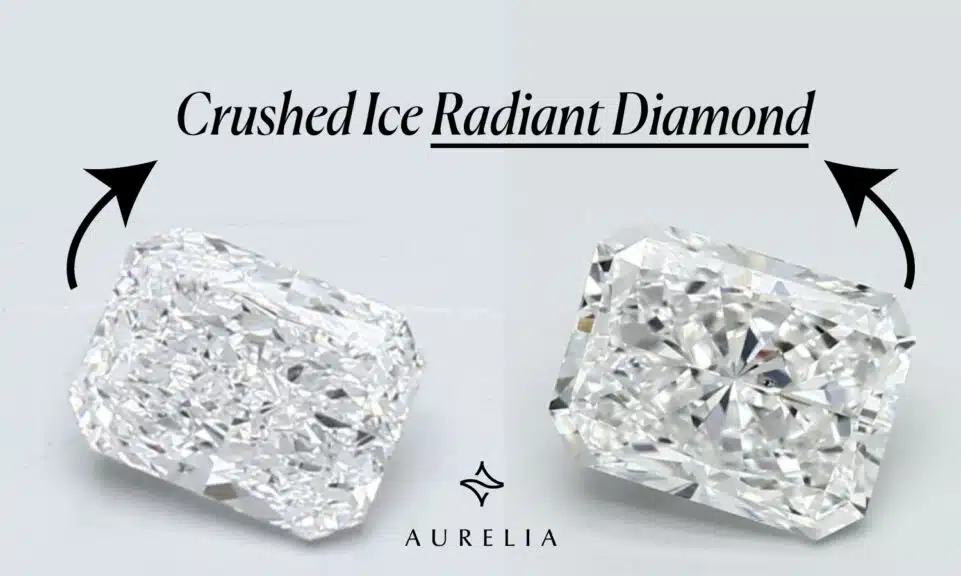
So, what is a radiant cut diamond when you see one? It’s a spectacle of light. The design features a stunning 70 facets, a complex arrangement that maximizes the stone’s ability to catch and reflect light. The result is a signature look that gemologists call “crushed-ice.”
- It’s a vibrant, scintillating sparkle that is incredibly lively.
- The light is chopped up into a thousand tiny pieces, creating a brilliant “blizzard” of light.
- This intense brilliance is second only to the round brilliant itself.
A radiant stone doesn’t just flash; it explodes with fire. It’s a choice for someone who wants an elegant rectangular shape without sacrificing any of the “wow” factor. It truly is the best of the brilliant vs radiant cut worlds.
A Jeweler’s Honest Breakdown: The Pros & Cons
Now, as your friend in the business, I need to give you the unvarnished truth. The radiant’s unique design gives it some incredible strengths, but it also comes with a unique set of challenges that can trap an unprepared buyer. Let’s lay it all out.
| The Pros of a Radiant Cut | The Cons of a Radiant Cut |
| Incredible Brilliance & Sparkle | GIA Does Not Assign a Cut Grade |
| Appears Larger Than Its Carat Weight | Potential for a “Bow-Tie” Effect |
| Excellent Value & Affordability | Shape Appeal (L/W Ratio) is Crucial |
| Very Durable (Cropped Corners) | Can Be Hard to Find in Local Stores |
My Mehedi’s Take: Let’s be clear about what this table is telling us. You are looking at a diamond that offers top-tier sparkle, a large visual size, excellent durability, and a fantastic price. It is, on paper, one of the best choices a savvy buyer can make.
However, that “Cons” column is where the risk lies. The challenges of a radiant cut are all technical nuances that you can’t see on a basic report. This is not a “buy it off the certificate” diamond. To unlock its incredible value, you have to know how to navigate its unique complexities, which is exactly what the rest of this guide will teach you.
For a full overview of how the radiant fits into the broader market, our complete Diamond Shapes Guide is an essential starting point.
My Expert Guide to Choosing the Perfect Radiant Diamond: Avoiding the 7 Critical Mistakes
Welcome to the most important section of this guide. We are now going to walk through the seven costly mistakes that I see buyers make every single day with the beautiful and complex radiant diamond. For each trap, I will give you a simple, powerful solution that will save you money and lead you to a truly spectacular stone.
Mistake #1: Overpaying for Clarity You Can’t See (The #1 Secret)
The Trap: A buyer knows that a step cut like an emerald requires a high clarity grade. They mistakenly apply this logic to the radiant cut, treating it like an unforgiving step cut and buying a VVS or VS1 clarity diamond “just to be safe.” This can cost them thousands of dollars unnecessarily.
James Allen: Our 5-Star Choice for Price and Selection
Check our comprehensive James Allen Review to learn more about their pricing and commitment.
The Mehedi Solution & The Big Secret: Embrace the Radiant’s Natural Camouflage!
Here it is, the #1 secret to the radiant cut diamond: its “crushed-ice” facet pattern is a master of camouflage. The dense, complex, and seemingly chaotic pattern of its 70 brilliant facets chops up light into a thousand tiny pieces.
This creates a dazzling “blizzard” of sparkle that is incredibly effective at hiding small inclusions. An inclusion that might be a glaring flaw in the open window of an emerald cut is completely swallowed by the fire of a radiant stone.
This is your ultimate advantage. Your goal is not a “flawless” certificate; your goal is an “eye-clean” SI1. An SI1 that looks clean to the naked eye is the value-hunter’s dream, and this is the perfect shape to find one.
For example, a savvy buyer might choose a beautiful 1.24 Carat, G Color, SI1 radiant from James Allen and save nearly 30% compared to a VS2 with no visible difference. This single tip is the secret that saves you thousands. To become an expert at spotting these, our SI1 Clarity Diamond Guide will turn you into a pro.
Mistake #2: Overpaying for Color You Can’t Perceive
The Trap: A buyer, determined to get a “perfect” ring, spends a massive premium on a D or E color diamond, believing it’s the only way to get a truly “white” look.
The Mehedi Solution & The Second Secret: Just like with clarity, the radiant’s intense brilliance helps to mask the diamond’s natural body color. That “crushed-ice” effect creates so much bright, white light return that it can make a lower color grade look whiter than it actually is.
My Expert Recommendation:
- An H color will look perfectly icy-white to the naked eye in any setting and costs significantly less than the colorless D-F grades. This is the ultimate sweet spot.
- For a radiant cut gold ring (yellow or rose gold), you can find incredible value by dropping down to an I or even J color, as the warmth of the metal will perfectly complement any subtle warmth in the stone. A gorgeous J color radiant from Blue Nile set in yellow gold can look stunningly white and save you nearly 50% compared to a D color.
Mistake #3: Ignoring the Bow-Tie Effect
The Trap: A buyer finds a great deal on a beautiful long radiant cut diamond ring but only looks at a static picture. When the ring arrives, they are disappointed to see a persistent dark shadow across the center, a dead zone that dulls the sparkle.
The Mehedi Solution: Be a Bow-Tie Hunter.
Like other elongated fancy shapes, any radiant vs elongated radiant can exhibit a “bow-tie” effect. This is a dark, bowtie-shaped shadow caused by facets that leak light. A severe, dark bow-tie is a deal-breaker and a sign of a less-than-ideal cut.
The 360° video is your non-negotiable tool for spotting this. Look for a stone where the center lights up as it turns and the bow-tie is minimal or completely absent. For a full breakdown of this phenomenon, our Oval Cut Diamond Buying Guide provides an excellent, in-depth explanation.
Mistake #4: Choosing the Wrong Shape (The L/W Ratio)
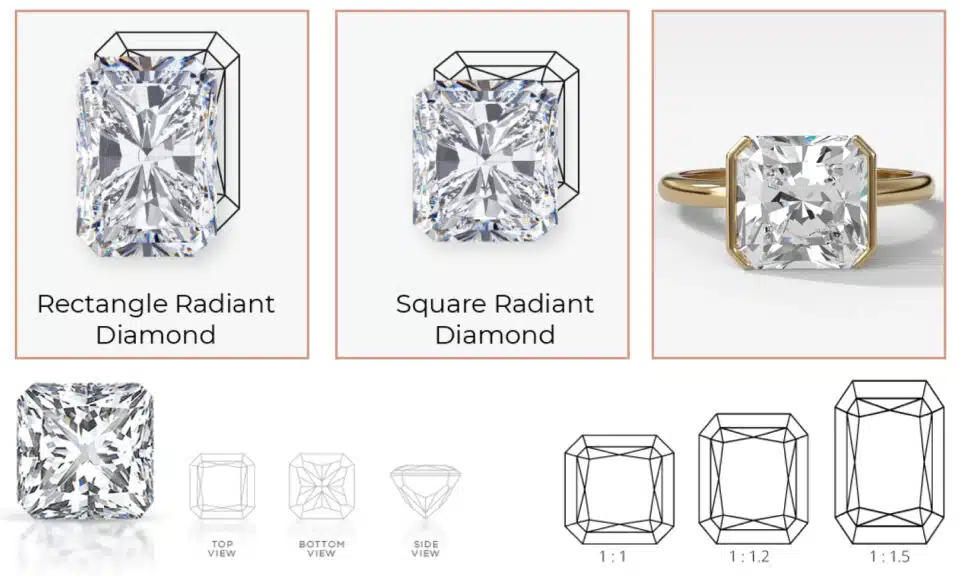
The Trap: A buyer has their heart set on a classic, elongated rectangle but accidentally buys a square radiant cut diamond, or vice-versa, because they didn’t pay attention to the measurements on the certificate.
The Mehedi Solution: Decide on Your Shape Before You Shop.
The radiant diamond shape is defined by its Length-to-Width (L/W) Ratio. You must decide which silhouette you prefer before you begin your search.
| L/W Ratio | Shape Description | Mehedi’s Expert Take |
| 1.00 – 1.05 | The “Square” Radiant | A perfect choice for a symmetrical, modern look. Competes directly with the Princess Cut. |
| 1.06 – 1.19 | The “Chubby” Rectangle | A less common, wider shape that can be very beautiful if well-cut. |
| 1.20 – 1.35 | The “Classic” Rectangle | This is the absolute sweet spot for that iconic, elegant, elongated radiant look. |
| > 1.35 | The “Elongated” Rectangle | A dramatic and finger-slimming look, perfect for a 5 ct radiant cut diamond ring. |
Use the L/W ratio filter on the retailer’s website. The best ratio for a radiant cut diamond is the one that you find most beautiful.
Mistake #5: Trusting a Certificate That Lacks a Cut Grade
The Trap: A buyer knows that GIA is the best lab, so they assume the GIA report for their radiant tells them everything they need to know about its quality.
The Mehedi Solution: You Must Be the Judge of the Cut.
As we’ve said, the GIA does not assign an overall Cut grade for the radiant cut. You must look at the certificate’s proportions as a starting point.
Mehedi’s Expert Starting Point for Radiant Proportions

- Table %: 61% to 69%
- Depth %: 61% to 67%
- Girdle: Very Thin to Slightly Thick
- Culet: None
These ideal radiant cut diamond proportions will help you filter out the majority of poorly cut stones. But your eyes, viewing the 360° video, are always the final judge.
Mistake #6: Forgetting About Polish and Symmetry
The Trap: A buyer focuses only on the main 4Cs and ignores the “minor” grades of Polish and Symmetry on the GIA report. They end up with a stone that has a chaotic and dull sparkle.
The Mehedi Solution: Insist on “Excellent” for Both.
For a radiant-cut diamond, which has both the long lines of a step cut and the brilliant facets of a round, these grades are critical.
- Poor Polish will make the facets look smudged, severely reducing the diamond’s brilliance.
- Poor Symmetry will cause the “crushed-ice” pattern to look uneven and disorganized, killing the stone’s fire.
My advice is firm: only consider stones with a grade of “Excellent” for both Polish and Symmetry. The price difference is negligible, but the visual impact is enormous.
Mistake #7: Buying It “Sight Unseen”
The Trap: Purchasing a radiant cut diamond based only on its certificate, without ever looking at a high-quality video.
The Mehedi Solution: High-Quality Video is Non-Negotiable.
Given all the variables we just discussed—the bow-tie, the L/W ratio, the symmetry, and the lack of a GIA cut grade—you simply cannot buy a radiant cut blind. A high-quality 360° video from a trusted retailer like James Allen or Blue Nile is your most powerful tool.
Blue Nile is one of the biggest and most recognized online jewelry retailers, offering an extensive and exclusive inventory. Their high-resolution images are improving and getting closer to the quality offered by James Allen, while their prices remain highly competitive. Right now, Blue Nile offers up to 30% savings on jewelry during a limited-time sale.
WHAT WE LOVE ABOUT THEM:
- 30-day no-questions-asked return policy, with a prepaid shipping label provided by Blue Nile.
- Lifetime warranty on all purchases.
- Free shipping on every order.
- Complimentary services every six months, including prong tightening, repolishing, rhodium plating, and cleaning.
- Insurance appraisal included with your purchase.
- One free resizing within the first year.
- High-quality images available for roughly half of their diamond selection.
- 24/7 customer service support.
- Full credit toward future upgrades, as long as the new item is at least double the value.
- Best-in-class order fulfillment process.
James Allen is a top leader in online diamond sales, offering cutting-edge imaging technology that lets you inspect diamonds as if you were using a jeweler's loupe. With the largest exclusive selection of loose diamonds available online and excellent pricing, they also boast one of the finest collections of lab-created diamonds on the market. They currently run a 25% discount on selected lab-grown diamonds!
WHAT WE LOVE ABOUT THEM:
- 30-day no-questions-asked return policy, with a prepaid shipping label provided by James Allen.
- Lifetime warranty on all purchases.
- Free international shipping.
- Complimentary prong tightening, repolishing, rhodium plating, and cleaning every six months.
- Insurance appraisals included with purchases.
- One free resizing within 60 days of purchase.
- Free ring inscriptions available.
- Best-in-class high-quality imagery for every diamond in stock.
- 24/7 customer support.
- Premium, best-in-class packaging.
It is the only way to confirm that a radiant diamond with a great certificate is a true, top-tier stunner in the real world. A perfect example of a showstopper that you can inspect from every angle is a stunning 2 Carat Radiant from Blue Nile.
Alright, you’ve mastered the seven mistakes to avoid and you now have the secrets to finding a spectacular radiant diamond. Now, let’s get down to the exciting part: your budget, the ring’s visual impact, and how it stacks up against its main rivals.
Radiant Cut Price and Size Chart
One of the biggest “pros” of the radiant cut is the incredible value it offers. Let’s look at the hard numbers.
A radiant cut diamond is significantly less expensive than a round brilliant of the same carat weight. You can expect to pay 20-35% less for a radiant. This is because its square or rectangular shape is more efficient to cut from a raw diamond crystal, resulting in less waste. That saving is passed directly on to you.
Here is a real-world sample pricing table for a high-quality, GIA-certified natural radiant cut diamond (in our “sweet spot” of G-H color, SI1-VS2 clarity).
| Carat Weight | Typical Price Range | Mehedi’s Expert Take: The Value You’re Getting |
| 1.00 Carat | $2,800 – $4,000 | A brilliant 1 carat radiant cut diamond ring for the price of a ~0.80ct round. |
| 2.00 Carat | $12,000 – $16,000 | A show-stopping 2 carat radiant cut diamond that feels incredibly substantial. |
| 3.00 Carat | $25,000 – $38,000+ | The ultimate 3 ct radiant cut diamond; a true luxury piece at a savvy price. |
Yes, they do! This is the radiant’s other superpower. The combination of its typically shallower cut and its long diagonal measurement creates a powerful optical illusion that makes it look larger than its carat weight. For example, a perfect 2 carat radiant cut diamond on finger can look as big as a 2.2-carat round brilliant.
Here is your radiant cut diamond size chart to help you visualize the typical face-up measurements (length x width).

| Carat Weight | Approx. Size (Classic Rectangle, L/W 1.25) |
| 1.00 ct. | 7.0mm x 5.5mm |
| 1.50 ct. | 8.0mm x 6.0mm |
| 2.00 ct. | 8.5mm x 6.5mm |
| 3.00 ct. | 9.5mm x 7.5mm |
Radiant vs. Its Main Rivals: The Ultimate Showdown
How does the radiant’s unique combination of features stack up against the competition? Let’s find out.
This is a showdown between two brilliant-cut rivals with soft corners. The choice comes down to shape and fire.
| Feature | Radiant Cut | Cushion Cut |
| Shape | Square or Rectangle (Sharp Lines) | Square or Rectangle (Soft “Pillow” Shape) |
| Sparkle | Scintillating “Crushed-Ice” Brilliance | “Crushed-Ice” or “Chunky” Fire |
| The “Vibe” | Modern & Energetic | Romantic & Vintage |
The Mehedi Verdict: If you love a sharp, clean, modern look with maximum brilliance, the radiant cut is for you. If you prefer a softer, more romantic, vintage feel with a bit more colorful fire, then the Cushion Cut Diamond is your perfect match. For a stunning example of the radiant, look at a 1.50 Carat, H-VS2 Radiant from James Allen.
This is a comparison of two modern, fiery cuts. The main difference is the corners.
| Feature | Radiant Cut | Princess Cut |
| Shape | Beveled, Cropped Corners | Sharp, Pointed Corners |
| Durability | Excellent (No sharp points) | Good (Corners are vulnerable & need protection) |
| Look | “Crushed-Ice” Brilliance | Sharp, Geometric “Mosaic” Sparkle |
The Mehedi Verdict: Think of the radiant as the more durable and practical cousin of the princess cut. It offers a very similar level of fiery brilliance but with cropped corners that make it far less prone to chipping.
If you love the sharp, modern look but have an active lifestyle, the radiant is the safer and, in my opinion, smarter choice. We explore the princess in full detail in our Princess Cut Diamond Ring Guide.
This is the ultimate head-to-head that inspired the radiant cut in the first place.
| Feature | Radiant Cut | Emerald Cut |
| Cut Style | Brilliant Cut (70 facets) | Step Cut (~57 facets) |
| Sparkle | Fiery “Crushed-Ice” Sparkle | Elegant “Hall-of-Mirrors” Flash |
| Clarity Needs | Excellent (SI1+ is easy to find) | Very High (VS2+ is essential) |
The Mehedi Verdict: This is a choice about the personality of your sparkle. The radiant cut is for the lover of fiery, energetic, traditional diamond brilliance. The Emerald Cut Diamond is for the connoisseur who prefers a more subtle, understated, and architectural elegance.
A perfect example of a show-stopping radiant is this beautiful 2.01 Carat, G-VS1 Radiant from Blue Nile, which shows off that incredible crushed-ice effect.
The Best Settings for a Radiant Cut Diamond
You’ve done the hard work and used our expert secrets to find a stunning radiant diamond that’s full of life and fire. Now for the most exciting part: choosing the perfect stage to showcase your masterpiece. The radiant cut diamond ring setting you choose will define the ring’s final personality, from timeless and classic to modern and glamorous.
Because a radiant already has its corners cropped for durability, you have a huge amount of freedom. Your primary goal is to choose a setting that complements its clean lines and lets its incredible “crushed-ice” sparkle be the absolute star of the show. Let’s walk through the top choices.
The Solitaire Setting: Pure & Confident
The solitaire is the quintessential choice for the purist who believes that a spectacular diamond needs no distractions.
This style is modern, minimalist, and incredibly confident. A simple 4-prong solitaire lifts the radiant cut gemstone up to the light, leaving it open on all sides. All of the focus is on the stone itself—its beautiful shape, its perfect proportions, and its explosive sparkle. It’s a timeless choice that will never, ever go out of style.
- Timeless, classic style
- Maximizes light entering the diamond
- Highlights the radiant’s unique shape
- Easy to clean and maintain
This is a phenomenal choice that allows the radiant’s complex facet pattern to do all the talking. I highly recommend a setting with a thin, delicate band, as this will make your 2 carat radiant cut diamond look even larger and more impressive by comparison.
For a flawless execution of this look, a classic thin-band solitaire setting from James Allen is the perfect benchmark for a diamond ring radiant cut.
Read Our 5-Star Blue Nile Review
Check our comprehensive Blue Nile review to learn why we rated Blue Nile 5 stars for their exceptional quality and value.
The Halo Setting: Maximum Brilliance & Glamour
If your philosophy is “more is more,” then a halo setting is the perfect way to turn your fireball into a full-on inferno of sparkle.
This style is glamorous, bold, and red-carpet-ready. The halo consists of a ring of tiny, brilliant pavé diamonds that perfectly traces the outline of your radiant shape diamond. This creates a seamless, jaw-dropping surface of continuous sparkle.
- Makes the center stone look significantly larger
- Adds an immense amount of extra sparkle
- Creates a seamless, high-glamour look
- Provides an extra layer of protection for the stone’s girdle
A halo works spectacularly with a radiant because the brilliant facets of the small halo stones perfectly complement the “crushed-ice” sparkle of the center stone—it’s a “fire-on-fire” combination. This is the ultimate choice for maximizing the “wow” factor of a 5 ct radiant cut diamond ring. For a perfect example of this style, look at a beautiful pavé halo setting from Blue Nile.
The Three-Stone Setting: Symbolic & Substantial
A three-stone setting is for the person who loves a ring with a deep, personal meaning and a substantial, impressive presence on the finger.
This style represents your journey as a couple: your past, your present, and your future. For a radiant cut diamond, this setting creates a stunning, architectural look with a beautiful horizontal spread of brilliance. It feels both significant and deeply romantic.
- Rich with personal symbolism
- Creates a larger, more substantial look
- Allows for unique customization with side stones
- Adds significant total carat weight
The choice of side stones is crucial here. For a radiant cut natural diamond ring, the most elegant pairings are often stones that provide a beautiful contrast. Two tapered baguette diamonds on the side create a stunning Art Deco look, with their clean, glassy flashes highlighting the radiant’s fiery sparkle.
For a perfect, real-world example, this three-stone setting with tapered baguettes from James Allen is a masterpiece of design. Understanding how different stones work together is a key part of our main Diamond Buying Guide.
Radiant Engagement Rings for Inspiration (Click a Ring for More Details)
-
3 Carat Radiant Cut Diamond Ring with G-VVS2 Diamond in French Pavé Platinum Setting
$51,060.00 -
Bow-Tie 2.5 Carat Radiant Cut Diamond Ring with D-VS2 Diamond in Yellow Gold
$52,620.00 -
D-IF 3 Carat Radiant Cut Lab Grown Diamond Ring | Petite Cathedral Solitaire
$13,580.00 -
D-VVS1 3 Carat Radiant Cut Lab Grown Diamond Ring | Twist Solitaire Yellow Gold
$10,480.00 -
D-VVS2 3 Carat Radiant Cut Diamond Ring | Mini Micropavé Yellow Gold
$56,750.00 -
Pavé Rope 2 Carat Radiant Cut Diamond Ring in 14K White Gold
$22,260.00 -
Petite Twist 2 Carat Radiant Cut Diamond Ring in 14k White Gold
$31,200.00
Your Radiant Cut Diamond Questions, Answered
You’ve got the expert blueprint for avoiding the common mistakes. Now, let’s dive into the specific questions that every savvy buyer has before making a final decision. Here are my direct, honest, and in-depth answers.
The Verdict: The Savvy Buyer’s Brilliant Choice
The radiant cut diamond isn’t just another shape; it’s a hybrid masterpiece designed from the ground up for brilliance, durability, and most importantly, value.
The #1 secret you’ve learned today is its incredible ability to act as a master of camouflage—hiding small inclusions and faint color in a dazzling display of crushed-ice sparkle. This is a massive advantage for you, the buyer.
You now have the expert knowledge that most people never get. By embracing the incredible value of an eye-clean SI1 clarity grade and hunting for a stone with beautiful proportions, you can get a bigger, more brilliant, and more beautiful radiant cut diamond than you ever thought possible. It is, without a doubt, the smartest brilliant cut on the market.
Continue Your Research Journey
You are now an expert on the radiant cut and armed with the secrets to finding an incredible stone for an even better price. If you’re ready to take the next step, compare the top retailers, or dive even deeper into the nuances of diamond quality, these hand-picked guides are the perfect place to continue your journey.
In-Depth Retailer Reviews
- The Industry Heavyweight: The Complete Blue Nile Review for 2024 – (https://moissanitebyaurelia.com/blue-nile-reviews-2024/)
- Another Top Contender: Is Ritani a Legit Place to Buy From? – (https://moissanitebyaurelia.com/is-ritani-legit/)
- The Ultimate Showdown: A Comparison of Astor vs. True Hearts Diamonds – (https://moissanitebyaurelia.com/astor-vs-true-hearts/)
Advanced Diamond Knowledge
- The Foundation: Our No-Nonsense Diamond Grading Chart (The 4 Cs) – (https://moissanitebyaurelia.com/diamond-grading-chart-4-cs-of-diamonds/)
- Considering a Modern Alternative?: An Expert Guide to the Types of Lab-Grown Diamonds – (https://moissanitebyaurelia.com/types-of-lab-grown-diamonds/)
- A Deep-Dive on Color: An Expert’s Guide to G Color Diamonds – (https://moissanitebyaurelia.com/g-color-diamond/)
Practical Guides & Strategies
- The Next Step After Purchase: What is the Definition of an Appraisal for a Diamond Ring? – (https://moissanitebyaurelia.com/definition-of-appraisal-for-diamond-ring/)
- See the Competition: The Ultimate Guide to the Asscher Cut Diamond – (https://moissanitebyaurelia.com/asscher-cut-diamond/)
- Understanding All Your Options: Where Are the Best Places to Buy Engagement Rings Online? – (https://moissanitebyaurelia.com/best-places-to-buy-engagement-rings-online/)
- Shop Radiant Cut Diamond Engagement Ring: https://moissanitebyaurelia.com/product-category/radiant-cut-diamond-engagement-rings/


